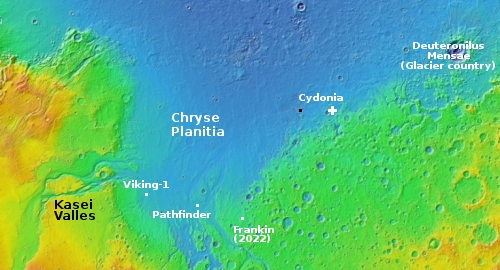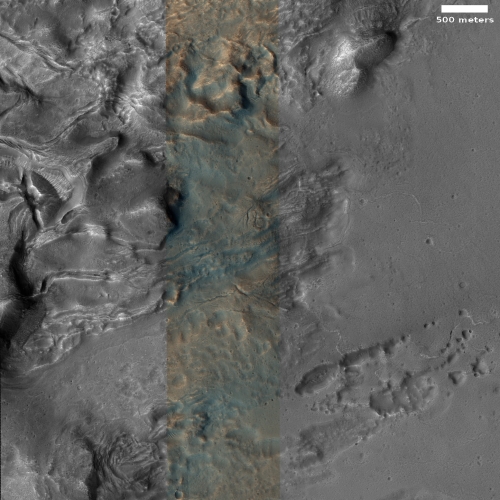A visit to Cydonia on Mars
Cool image time! The Cydonia region on Mars, located at around 30-40 degrees north latitude in the northern lowland plains just beyond the transition zone up to the southern cratered highlands, is well known to many on Earth because it was here that the Viking-1 orbiter took a picture of a mesa that, because of the sun angle, made its shadows resemble a face. Thus was born the “Face on Mars” that consumed the shallow-minded among us — and thus the culture, media, and Hollywood — absurdly for decades, until Mars Global Surveyor took the first high resolution image and proved without doubt what was really obvious from the beginning, that it was nothing more than a mesa.
Cydonia however remains a very intriguing region of Mars, mostly because it is home to a lot of strange geology, as shown by the photo to the right, rotated, cropped, and reduced to post here. Taken on January 16, 2021 by the high resolution camera on Mars Reconnaissance Orbiter (MRO), it shows some of that strange and inexplicable geology.
While Cydonia is inside that 30-60 degree latitude band where MRO has imaged numerous glacial-type features, I do not know if many such features have been found there. Except for the pits and depressions in the photo’s lower right — which suggest decay in an ice sheet — little else at first glance in the picture clearly invokes any of the obvious glacial features one comes to expect. There appear to be what might be lobate flows in the image’s center going from the west to the east, but if they are glacial, they are so decayed to as leave much doubt.
The overview image below shows where Cydonia is on Mars, and helps explain partly what is found here.

The white cross marks the location of today’s photo. The black dot indicates the location of the “face” mesa.
Cydonia sits mostly in the northern lowlands. Though the region has many knobs and mesas that resemble the chaos terrain like the glacier country in Deuteronilus Mensae to the east, much of its chaos appears to be in its final stages of erosion, so that it is more a plain of small knobs and mesas than a region of cross-cutting canyons with large mesas in-between. Thus if there is buried ice here, rather than finding it in glaciers flowing off mesas it is more probably locked in underground ice sheets, as suggested in the lower right of today’s cool image.
In fact, the wider view provided by MRO’s context camera of this same place, rotated, cropped and reduced and posted below, makes its ice-filled geology more evident, though still far from certain. The craters in the wide view seem filled with some debris, and in numerous spots across the entire terrain there appear what to my eye look like corroding glaciers.
This is all a guess on my part, based on what I now know of Mars’ geology and how driven it appears to be by latitude. The white box below marks the location of the close-up image above.

On Christmas Eve 1968 three Americans became the first humans to visit another world. What they did to celebrate was unexpected and profound, and will be remembered throughout all human history. Genesis: the Story of Apollo 8, Robert Zimmerman's classic history of humanity's first journey to another world, tells that story, and it is now available as both an ebook and an audiobook, both with a foreword by Valerie Anders and a new introduction by Robert Zimmerman.
The print edition can be purchased at Amazon or from any other book seller. If you want an autographed copy the price is $60 for the hardback and $45 for the paperback, plus $8 shipping for each. Go here for purchasing details. The ebook is available everywhere for $5.99 (before discount) at amazon, or direct from my ebook publisher, ebookit. If you buy it from ebookit you don't support the big tech companies and the author gets a bigger cut much sooner.
The audiobook is also available at all these vendors, and is also free with a 30-day trial membership to Audible.
"Not simply about one mission, [Genesis] is also the history of America's quest for the moon... Zimmerman has done a masterful job of tying disparate events together into a solid account of one of America's greatest human triumphs."--San Antonio Express-News
Cool image time! The Cydonia region on Mars, located at around 30-40 degrees north latitude in the northern lowland plains just beyond the transition zone up to the southern cratered highlands, is well known to many on Earth because it was here that the Viking-1 orbiter took a picture of a mesa that, because of the sun angle, made its shadows resemble a face. Thus was born the “Face on Mars” that consumed the shallow-minded among us — and thus the culture, media, and Hollywood — absurdly for decades, until Mars Global Surveyor took the first high resolution image and proved without doubt what was really obvious from the beginning, that it was nothing more than a mesa.
Cydonia however remains a very intriguing region of Mars, mostly because it is home to a lot of strange geology, as shown by the photo to the right, rotated, cropped, and reduced to post here. Taken on January 16, 2021 by the high resolution camera on Mars Reconnaissance Orbiter (MRO), it shows some of that strange and inexplicable geology.
While Cydonia is inside that 30-60 degree latitude band where MRO has imaged numerous glacial-type features, I do not know if many such features have been found there. Except for the pits and depressions in the photo’s lower right — which suggest decay in an ice sheet — little else at first glance in the picture clearly invokes any of the obvious glacial features one comes to expect. There appear to be what might be lobate flows in the image’s center going from the west to the east, but if they are glacial, they are so decayed to as leave much doubt.
The overview image below shows where Cydonia is on Mars, and helps explain partly what is found here.

The white cross marks the location of today’s photo. The black dot indicates the location of the “face” mesa.
Cydonia sits mostly in the northern lowlands. Though the region has many knobs and mesas that resemble the chaos terrain like the glacier country in Deuteronilus Mensae to the east, much of its chaos appears to be in its final stages of erosion, so that it is more a plain of small knobs and mesas than a region of cross-cutting canyons with large mesas in-between. Thus if there is buried ice here, rather than finding it in glaciers flowing off mesas it is more probably locked in underground ice sheets, as suggested in the lower right of today’s cool image.
In fact, the wider view provided by MRO’s context camera of this same place, rotated, cropped and reduced and posted below, makes its ice-filled geology more evident, though still far from certain. The craters in the wide view seem filled with some debris, and in numerous spots across the entire terrain there appear what to my eye look like corroding glaciers.
This is all a guess on my part, based on what I now know of Mars’ geology and how driven it appears to be by latitude. The white box below marks the location of the close-up image above.

On Christmas Eve 1968 three Americans became the first humans to visit another world. What they did to celebrate was unexpected and profound, and will be remembered throughout all human history. Genesis: the Story of Apollo 8, Robert Zimmerman's classic history of humanity's first journey to another world, tells that story, and it is now available as both an ebook and an audiobook, both with a foreword by Valerie Anders and a new introduction by Robert Zimmerman.
The print edition can be purchased at Amazon or from any other book seller. If you want an autographed copy the price is $60 for the hardback and $45 for the paperback, plus $8 shipping for each. Go here for purchasing details. The ebook is available everywhere for $5.99 (before discount) at amazon, or direct from my ebook publisher, ebookit. If you buy it from ebookit you don't support the big tech companies and the author gets a bigger cut much sooner.
The audiobook is also available at all these vendors, and is also free with a 30-day trial membership to Audible.
"Not simply about one mission, [Genesis] is also the history of America's quest for the moon... Zimmerman has done a masterful job of tying disparate events together into a solid account of one of America's greatest human triumphs."--San Antonio Express-News



Perhaps lower gravity shapes erosion differently. The “face” wasn’t as interesting to me as a nearby feature that resembled the state of Alabama-minus Mobile.
Thanks for the heads up. I’ve never listened to the Space Show live, always via Podcast. But I may try to stay up for this one!
No telling what atmosphere Mars once had too. Any guesses on atmosphere compositions and effects?
Hi, I can’t find the face or any of the often mentioned features.
Could you circle the face area so I can find it?
Ed: It is your kind of comment that makes me grumpy. If you would read my article, you would see that I provided links to articles with images of the “face” mesa. You would also discover that the map I provided provides the location, well to the west of the subject image.
As I say, you need to read things to get your questions answered. I am continually surprised how many people no longer know how to do this.
The “Face” never spooked me like Miranda-which all but looked strip-mined